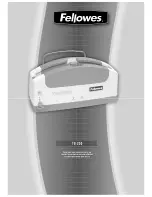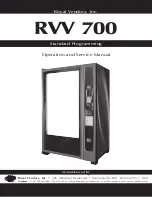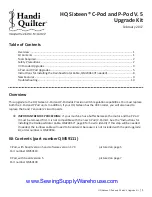
4
O p e r a t i o n
Before binding the first document, you should punch several sheets of scrap paper to remove any
factory-applied g r e a s e that might remain on the cutting dies. To do this, follow the s ta nda rd punching
p r o c e d u r e:
• Raise the lever
$
to a vertical position
• Make your sheets into a neat stack
• Slide the stack into the comb-punch entry
(
• Tap the stack gently into the entry and against the edge guide
'
on the left
• Pull the lever
$
toward the front of the machine and press down firmly
• Raise it back to a vertical position and remove the paper.
Repeat this a few times until the edges of the holes are clean. The machine is now r ea dy for us e.
The first step in comb-binding is to prepare the machine to accommodate your
document’s length and size:
1 . Select the comb . As shown, lay the stacked document, including covers, on the
machine where you see a ruler
%
calibrated from 6 to 22 mm (1/4” to 7/8”).
The right comb size will be the first one visible above the document. If the docu-
ment is on the border between two comb sizes, it’s generally better to choose the
larger size.
2 . Ad just center ing of docume nt, if necessary. Your machine is factory-set to punch
holes in the document size(s) most common to your geographic region, but if your sheets are some-
what larger or smaller, you may need to adjust the centering somewhat. Put in a sheet of scrap paper
of the same size and punch it, following the standard procedure (p. 4). If the row of holes is not cen-
tered along the document edge, loosen the thumbscrew of the edge guide
'
and slide it a little in one
direction or the other, as necessary, and retest. When you are satisfied with the centering, tighten the
thumbscrew to fix the position. (Note: Although a range of document sizes is marked on your machine,
yours will punch only the size(s) of your particular region.)
Now you are ready to do your p u n c h i n g, which you can combine with ordering your document.
Following the standard punching procedure:
• Punch the front cover and lay it face down next to the machine
• Punch the document in batches of no more than 8 sheets, laying them face down on top of the front
c o v e r, and
• Punch the back cover, laying it on top of the last page.
When you have finished punching the document, then:
• Op en t he comb. Position the comb behind the rake
#
with the comb opening toward the top. Pu s h
the comb firmly down between the rake teeth and push the lever
$
toward the back of the machine,
releasing it when the comb teeth have uncurled enough to allow easy insertion of the document. (If
pushing the lever
$
does not uncurl the comb, you need to turn it over. )
• Ins er t the document. Turn over the stacked document and insert the front cover into the comb.
(The front cover should be first so that the comb opening is hidden at the back.) Then, taking as many
sheets as you can reasonably handle, line up the holes and insert them into the comb, putting in the
back cover last.
• Clos e the comb . Simply pull the lever
$
toward you, back to its original vertical position, and lift out
the finished bound document.
Summary of Contents for PB 55
Page 1: ...PB 55...
Page 3: ......



























